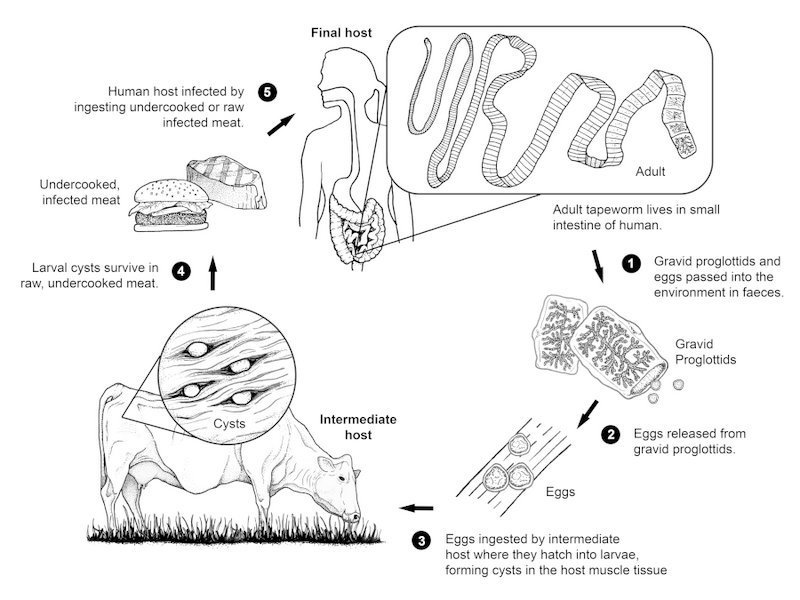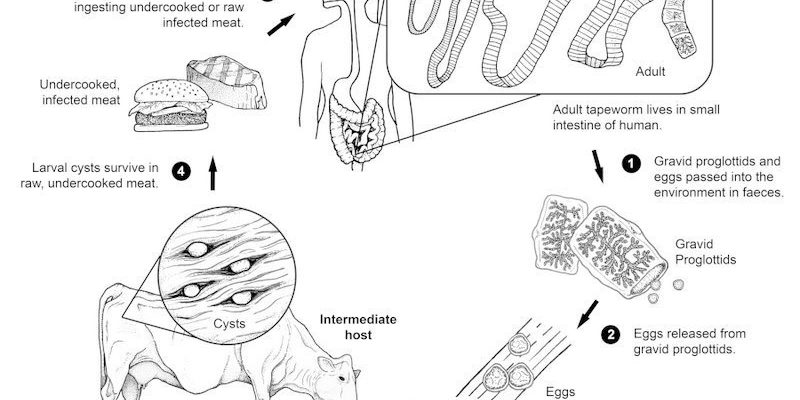
Tapeworms belong to a group of flatworms called *Cestoda*. They can be found in various hosts, including humans, dogs, and cattle. While they might be a nuisance, their method of reproduction is quite efficient. In this blog post, we’ll explore tapeworm mating, the lifecycle of their eggs, and how larvae develop. Get ready for a journey that uncovers the mysteries of these intriguing organisms!
How Do Tapeworms Mate?
When it comes to reproduction, tapeworms have a unique approach. Most tapeworms are hermaphrodites, which means each adult worm has both male and female reproductive organs. You can think of them as the ultimate multitaskers! This setup allows them to mate with themselves or with other tapeworms easier, increasing their chances of reproduction.
During mating, two tapeworms will align themselves to exchange sperm. They don’t have a fancy courtship dance; instead, they simply connect and transfer their sperm. After copulation, the fertilized eggs begin to develop within their bodies. This method of reproduction is not only fascinating but also very efficient. With so many eggs being produced, it’s no wonder tapeworms can be so prevalent!
The Process of Fertilization
Once the sperm is exchanged, fertilization happens internally. The fertilized eggs begin to develop into segments called proglottids, which are essentially the building blocks of the tapeworm’s body. Each proglottid contains a complete set of reproductive organs and can eventually produce hundreds to thousands of eggs. It’s a factory of new life, churning out future tapeworms one segment at a time!
After a certain number of proglottids have formed, they detach from the main body of the tapeworm. This is where things get really interesting. Depending on the species, these segments can either live in the host’s intestines or be expelled into the environment to continue the cycle of life.
Tapeworm Eggs: A Closer Look
The eggs produced by tapeworms are truly fascinating. They are often encased in a thick shell that protects them from the hostile environments outside a host’s body. Each tapeworm species produces eggs that have specific characteristics, which helps in identifying them.
Here’s what you should know about tapeworm eggs:
- Size: Tapeworm eggs are tiny—usually around 30 to 50 micrometers in diameter. That’s about the size of a fine grain of sand!
- Shape: They often have a round or oval shape, which helps them withstand digestion.
- Embryo: Inside, the eggs contain embryos that can develop into larvae once they find the right host.
The journey of these eggs doesn’t end with their production. They can be excreted with the host’s feces, ready to infect a new host, which might be a different animal or even a human. This adaptability is what makes tapeworms such successful parasites.
The Importance of Egg Survival
Egg survival is crucial for tapeworms. The tough outer shell allows them to withstand harsh environments, preventing them from drying out or being digested. Once they’re in the right conditions—like a suitable host’s intestines—they can hatch and continue the life cycle. Isn’t it amazing how nature has equipped them to thrive in such challenging situations?
The Lifecycle of Tapeworms
Understanding the lifecycle of tapeworms gives you a clear picture of their reproductive success. After being ingested by a suitable host, the eggs hatch into larvae within the intestines. Here’s a simplified version of their lifecycle:
1. Egg Stage: Eggs are excreted in feces and can survive in the environment.
2. Larval Stage: Once a host (like a pig or cow) ingests the eggs, they hatch into larvae that penetrate the intestinal wall and migrate to tissues.
3. Cystic Stage: The larvae continue to develop into cysts, which can stay dormant for years.
4. Adult Stage: If another host (like a human) consumes undercooked or contaminated meat, the cysts develop into adult tapeworms in the intestines.
This cycle can repeat multiple times, leading to mass infection within a population. By understanding this lifecycle, we can better appreciate why tapeworm infestations can be so challenging to control.
How Do Larvae Develop?
The development of tapeworm larvae is a critical part of their lifecycle. After the eggs hatch in the intestines of an intermediate host, they turn into larvae, often known as cysticerci. This stage is like a waiting game, where the larvae remain in a dormant state until the right conditions come along.
Once the larvae settle within the tissues of the host, they can remain there for months or even years. This stage is fascinating in that the larvae can escape the host’s immune system, allowing them to thrive undetected. If a definitive host (like a human) ingests the infected tissue, the larvae develop into adult tapeworms, starting the cycle anew.
Why Larvae Matter in Tapeworm Reproduction
The development phase of tapeworm larvae is crucial. It not only ensures the survival of the species but also plays a role in how effectively they can spread. The more robust their encysted state is, the better chances they have of finding a new host.
In short, larvae are the bridge between the egg and adult stages, and their ability to wait patiently for the right opportunity is a key survival strategy.
The Impact of Tapeworm Reproduction on Hosts
While tapeworms have a clever way of ensuring their survival, their reproduction can have significant consequences for their hosts. The presence of tapeworms in a host’s intestines can lead to various health issues, especially if the infestation is severe. Symptoms can include:
- Weight Loss: Despite eating normally, infected hosts can lose weight due to nutrient absorption issues.
- Abdominal Pain: The presence of the tapeworm can cause discomfort and pain.
- Malnutrition: Tapeworms can absorb nutrients meant for the host, leading to deficiencies.
Understanding the impact of tapeworm reproduction on hosts is key to addressing infestations. Many people don’t realize the potential dangers until symptoms arise, underscoring the need for awareness and preventive measures.
Preventing Tapeworm Infestation
Now that we know how tapeworms reproduce and the lifecycle they undergo, you might be wondering how to prevent an infestation. Here are some practical tips:
1. Cook Meat Thoroughly: Make sure to cook meat to safe temperatures to kill any possible larvae. This is especially important with pork and beef.
2. Practice Good Hygiene: Wash your hands regularly, especially after handling food or using the restroom.
3. Avoid Contaminated Water: Drink clean, treated water to reduce the risk of ingesting tapeworm eggs.
4. Regular Veterinary Care for Pets: If you have pets, ensuring they receive regular check-ups can help prevent infestations from spreading to humans.
These steps can help keep you and your family safe from tapeworms. Knowledge is a powerful tool in preventing tapeworm reproduction and ensuring that we stay healthy.
In conclusion, tapeworm reproduction is an intricate and fascinating process. From mating to the lifecycle of their larvae, these creatures showcase the resilience of nature. Understanding how they reproduce helps us not only appreciate the complexity of life but also take steps to protect ourselves from their impacts. So the next time you hear about tapeworms, you’ll know there’s a whole lot going on beneath the surface!

